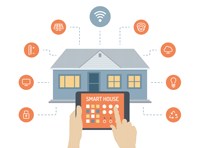Why Smart Homes are Keeping Seniors at Home Longer
Why Smart Homes are Keeping Seniors at Home Longer

According to the American Association of Retired Persons, 90 percent of older adults would prefer to stay in their homes as long as possible. This comes as no surprise to most people.
What may come as a surprise, however, is the pivotal role technology plays when it comes to keeping seniors at home. And it isn’t just seniors who are happy about this new technology. Adult children appreciate the peace of mind that comes with knowing their parent is safe at home, and that if something does go wrong with their loved one, they will be alerted immediately. They also appreciate that equipping their parent’s home with smart technology is significantly less expensive than moving them to an assisted living facility or a nursing home.
If you are considering outfitting an elderly parent’s home with the latest smart home technology, it can be tough to know which products or services are worth investing in and which are just hype. What follows is a list of the products that most experts on aging agree are worth the investment.
- Activity-based sensors. Discretely placed throughout the home, non-invasive sensors monitor the activity of a loved one. For example, if an elderly person hasn’t gotten out of bed for several hours or hasn’t opened the refrigerator the entire day, a family member will be alerted.
- Fall detection pendants. These devices are nothing new—we all remember the “I’ve fallen and I can’t get up” ads—but the technology behind them has evolved significantly. Today’s fall detection wearables include things like Wi-Fi and GPS to help families locate their parent in an emergency. They also no longer require a senior to press a button to call for help. Instead, these devices are programmed to call 911 and loved ones in the event of a fall.
- Medication dispensers. The new generation of medication dispensers not only remind older adults to take their medication through the use of alarms or flashing lights, they also do things like dispense the correct number of pills. Further, since they will only dispense one dose of medication at a time, they eliminate the danger of seniors repeating a dose because of forgetfulness.
- Smart doorbells, lights and thermostats. Seniors who want to turn on or off lights, adjust the temperature in their home or even see who is at the door can now do all of this from a smartphone, remote control or even through voice commands. This prevents older adults from having to repeatedly get up and down, reducing the likelihood of trips or falls.
- Video chatting. Whether you are across town or across the country, there are endless options for talking with your elderly parent face-to-face. One of the best things about video chats is that they allow a loved one to notice any changes in a parent’s appearance. Further, seeing their children and grandchildren can do wonders for a senior’s mental health!
Despite the benefits of this new technology, many older adults bristle at what they view as an invasion of their privacy. After all, no one wants to feel as if they are being spied on. Thankfully, there are some non-intrusive alternatives. Wearable technology, much like fitness tractors, will alert family members if there is a dramatic drop in movement.
Researchers at the Michigan State University are taking it a step further by studying how to use existing Wi-Fi signals in a home to detect changes in activity levels. This also would alleviate the burden of having to set up sensors or make sure that a parent is wearing a fall detection pendant, for example.
It is easy to see how the time, effort and research dollars being poured into smart technology for seniors has paid off. Today, more and more older Americans have the ability to live alone while diminishing the dangers of being alone.
Contact the professionals at Physicians Choice Private Duty to talk about your family. 402.331.CARE (2273)
